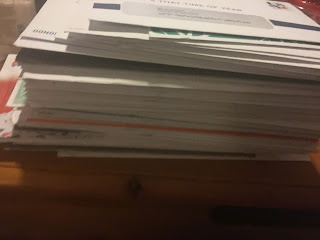Yup. That's 72 envelopes. They came in all shapes and sizes but out of the 72 I received 51 #10 envelopes with letters. Seriously? a #10 envelope?
4 sets of address labels, shame shame, some even came with gift labels.
Then there's the really bad appeals from places you give once to and they'll never ask again- that's just not true and is a horrible way to represent our profession.
It could be worse, you could have received this "fake" Christmas card with a big green ask in the middle, I call it the grinch of direct mail!
And some folks have ignored some pretty important details, the reply devices weren't personalized at all- which made me think they didn't put any effort into their devices. I shouldn't have to rewrite my address and gift amount, it should already be printed on my form for me. Here's an example of one that missed the mark:
Instead, they could have already included my information and my last years of giving and where I gave like these folks did-
They did great at targeting my asks based on past giving- But these two, not so much. If my last gift is $25 where did $500 for an alumnus come from? I'm not an alumna! Or at UVA, my last gift, also $25 and the lowest amount they're asking me for is 10 times that amount! WOAH- Really? And the first ask is 100 times that amount! CRAZY!
What have you received in your mailbox? Can you understand why some of this behavior is indefensible? How can we encourage folks to do better at direct mail? Why do they ignore communication preferences of their donors? My recycling was a wasteland of BREs and CREs. And next week, we go deep diving into my email folder of solicitations. Join me!
What are your thoughts? How was your mailbox?
Cheers,
Lynne











































